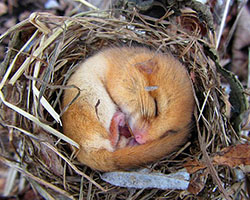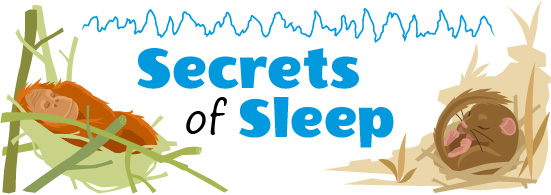Biology of Sleep

If you poke around on the ground of temperate forests during the winter, you might come across a dormouse burrow. Inside, the critter will be rolled up with its eyes closed and snout firmly tucked under its tail. It looks like it’s sleeping—but it’s not, it’s hibernating.
Hibernation and sleep are two types of rest. Torpor, coma, and dormancy are some other types of rest. In order to discern sleep from other types of rest, scientists have defined some characteristics of sleep.
Cyclic Changes in the Brain
With the help of EEG recordings, we know that activity in the brain changes between being awake and asleep. Sleep can be broken down into two main types: Rapid eye movement (REM) sleep and non-REM (NREM) sleep. During REM sleep, your eyes move rapidly behind your closed eyelids and your brain is very active. In fact, the EEG signals look very much like those when you are awake. However, the brain has a mechanism that stops signals from activating the muscles in your arms and legs. This prevents you from moving during REM sleep and acting out your dreams. During NREM sleep, your brain is still active. However, if you look at EEG recordings during NREM sleep, you will see high-voltage slow-wave activity that look like big waves.

In a healthy adult, sleep will cycle through five stages. There are four stages of NREM sleep and one stage of REM sleep. The average NREM-REM cycle is 90 minutes long. However, as we age, we tend to have less and less REM sleep.
Changes in Body Temperature
Your body temperature slightly drops when you prepare to sleep. Biologists think that this slight decrease is to help signal the body that it’s time for bed. During REM sleep, your body stops controlling its temperature and can continue to cool if you’re not sleeping under the covers. However, because your body cycles between REM and NREM sleep, it never stops monitoring your body temperature for too long.

Change in body temperature is one of the characteristics that separates sleep from deeper forms of rest. During hibernation, body temperature can drop to around freezing temperatures! Such low body temperatures halt most internal processes such as digestion and reproduction.
Low Responsiveness
Some people can sleep through anything: crying babies, slamming doors, wailing ambulances. Indeed, during sleep, the body is much less responsive to disturbances than when it is awake. However, when compared to hibernating animals, sleeping animals are more responsive and more easily awakened.
Read more about: Secrets of Sleep
Bibliographic details:
- Article: Biology of Sleep
- Author(s): Dr. Biology
- Publisher: Arizona State University School of Life Sciences Ask A Biologist
- Site name: ASU - Ask A Biologist
- Date published:
- Date accessed:
- Link: https://askabiologist.asu.edu/biology-sleep
APA Style
Dr. Biology. (). Biology of Sleep. ASU - Ask A Biologist. Retrieved from https://askabiologist.asu.edu/biology-sleep
Chicago Manual of Style
Dr. Biology. "Biology of Sleep". ASU - Ask A Biologist. . https://askabiologist.asu.edu/biology-sleep
Dr. Biology. "Biology of Sleep". ASU - Ask A Biologist. . ASU - Ask A Biologist, Web. https://askabiologist.asu.edu/biology-sleep
MLA 2017 Style

A huddled group of hibernating Virginia big-eared bats. Some animals experience near-freezing body temperatures during hibernation.
Be Part of
Ask A Biologist
By volunteering, or simply sending us feedback on the site. Scientists, teachers, writers, illustrators, and translators are all important to the program. If you are interested in helping with the website we have a Volunteers page to get the process started.

